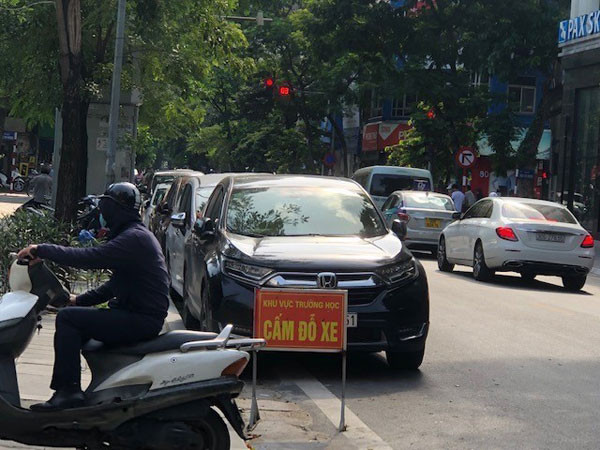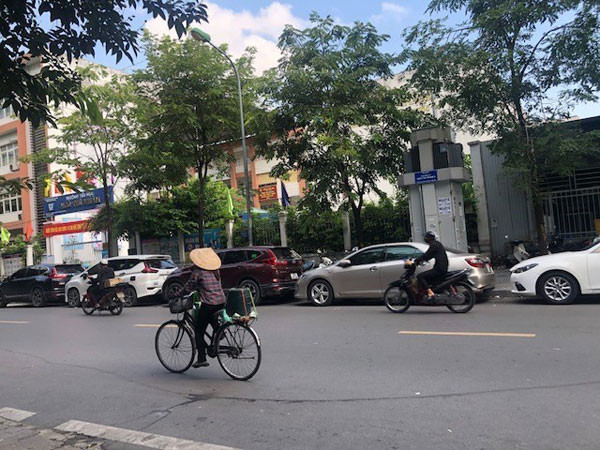
With the public transport system unable to fully cope with demands of commuters, an increasing number of personal vehicles in Hanoi is putting further pressure on the city’s infrastructure, especially parking facilities and services.
According to the Traffic Police Department of Hanoi, the capital city saw 239,045 newly-registered vehicles in 2021, of which, 60,926 are cars, 171,797 motorcycles, and 6,322 electric motorbikes.
These figures took the total number of vehicles in Hanoi to more than 7.5 million, along with over 1.2 million others from nearby localities also joining the traffic flow in the city.
While the number of personal vehicles continues to rise, parking lots and stations only account for 0.12 per cent of the area of the inner districts, meeting just 10 per cent of the demand.
The situation has led to numerous unregulated parking lots appearing in vacant spots: from alongside pavements and alleyways, to the yards inside schools, office buildings, apartment blocks, residential areas, as well as empty lots of new and unconstructed projects.
According to Hanoi Department of Transport, developing parking spaces in the city is an issue that departments of all levels are focusing on. Private investments are also mobilised to mitigate the problems.
However, implementation still meets multiple obstacles related to policies, budget, and the capacity of investors.
Dang Tien Nam, head of the Hoan Kiem District Traffic Inspection Team, said: “Hoan Kiem District has more than 300 authorised parking lots, and the rest are unregulated.
“These illegal spaces are taking up the space of streets, pavements and alleyways. Violations occur most often during holidays and major events.
“In the first six months of this year, the Traffic Inspection Team of Hoan Kiem District has addressed 72 violation cases and issued VND200 million (US$8,500) in fines.”
A recent case around Giap Bat Station was brought to light after local residents reported that unregulated parking spots sprung up along the roads and pavements in the area, and were imposing a much higher fee than the city’s regulations.
They were charging up to VND20,000 (US$0.85) per vehicle, while the regulations state that parking fee is VND5,000 ($0.2) during the day, VND8,000 ($0.3) during the night, and VND12,000 ($0.5) for the whole day.
Nguyen Duc Chinh, deputy chairman of Giap Bat Ward People’s Committee, said: “The ward’s committee and police are aware of the violations in this area and have conducted multiple inspections, but are yet able to eradicate this difficult issue.”
There are similar situations in other districts. Ba Dinh District last year saw 35 illegal parking lots, while this figure in Hoang Mai District was 82.
Along the narrow Hoa Ma Street in Hai Ba Trung District, cars can be seen lining up right next to a no-parking sign in front of Ngo Thi Nham Elementary School.

Other vehicles were also parked along the two sides of the road, and on the Thi Sach Street nearby.
According to Nguyen Thi Thuy Huong, director of Hanoi Parking One Member Co. Ltd, the large number of unregulated parking areas is having a negative impact on the city’s budget. Stringent and immediate measures from authorities are needed to address the issue.
Assessment from the Hanoi Department of Transport also revealed that parking lots in the city centre are very limited due to high population density and enormous demands.
To relieve the pressure on infrastructure, the city’s focus is to put on calling private investors to build new parking lot projects in annual investment promotion conferences.
Other measures include administration reforms and rapid land clearance to attract more qualified investors.
Hanoi Department of Transport also issued a temporary permit to 31 service providers to use parts of the roads for parking, with a total area of 31,705 square metres across 134 streets.
In addition, 12 out of 30 districts were granted permission to use a combined area of 91,930 square metres for parking services, with fee collection and submission to the State budget as per regulations.
This measures aim to not only reduce the pressure on parking services but also contribute to State coffers.
The traffic inspection unit is also tasked with developing annual plans and coordinating with the city's police and finance department, and local People's Committee to conduct reviews and address parking violations.
In 2019, the city People's Council also issued a resolution that addresses issues related to investment, aiming to ensure feasibility as well as a balance in interests among the stakeholders.
Notable policies include incentives on loans and access to capital sources, land lease and allocation, import tax support for advanced technology and equipment, and diversifying investor profiles.
Underground and multi-storey parking garages in the city, funded by private investors, have been built and gone into operation, receiving a positive reaction from the people.
Dao Ngoc Nghiem, architect and deputy chairman of Vietnam Urban Planning and Development Association, said: “The main reason why parking lot projects are not yet attractive to investors is the undefined key objective of these spaces.
“If we consider this matter a profitable industry, a comprehensive and feasible policy is needed.
“Organising underground spaces needs to be completed soon to increase parking areas, alongside mobilising people’s resources and a penalty policy for violations.”
Hanoi People's Committee recently approved a master plan for urban underground construction by 2030 with a vision for 2050.
According to the document, there will be 78 parking lots in four old inner districts, taking up a total area of 104 hectares.
From now until 2025, Hanoi will focus on 204 public parking projects within the city, with a budget of VND29.8 trillion ($1.27 billion).
Source: Vietnam News